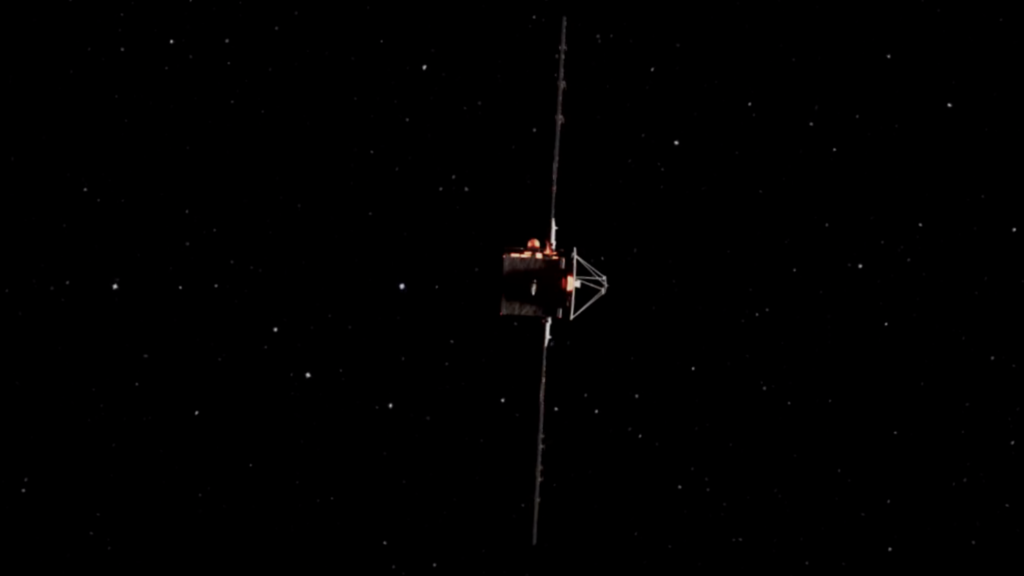
True Anomaly’s Jackal spacecraft will be able to pursue maneuvering adversary space vehicles to keep tabs on their whereabouts and activities in any orbital regime. (True Anomaly)
WASHINGTON — Barely a year old, Colorado-based startup True Anomaly already has caught the attention of the Space Force for its planned artificial intelligence-powered software and highly maneuverable satellites designed to pursue and image adversary spacecraft, according to CEO Even Rogers.
True Anomaly in January nabbed a direct-to-Phase 2 Small Business Innovation Research (SBIR) grant from Space Systems Command, and expects to deliver its software package in “the April, May timeframe,” he told Breaking Defense in an interview.
“The core of what we’re doing is software. The product we’re developing is an operating system for advanced maneuver, movement and other joint functions in the space domain,” Rogers told Breaking Defense. “And so what we’ve been funded by Space Systems Command to do is some sort of application development and the maturation of that software to help the Space Force orient space battle managers and orbital warfare operators to the environment and execute missions.”
True Anomaly’s software for mission management also can be used as a wargaming and training environment, similar to a video game where operators go up against a “thinking adversary” in the form of a artificial intelligence (AI) “agent,” Rogers explained. And while the current SSC contract doesn’t include it, he said there also is a contract for Guardian training in the works for “later this year.”
The Space Force is not only interested in True Anomaly’s software, he said, but also intrigued by its planned Jackal spacecraft, which the company says will be able not just to keep tabs on maneuvering satellites and/or spacecraft, but, uniquely, also to chase them down if they try to get away to avoid surveillance.
Jackal is “an autonomous orbital pursuit vehicle,” Rogers said, able to conduct “uncooperative rendezvous and proximity operations missions,” with “uncooperative” targets, meaning satellites/spacecraft that are actively trying to hide.
“That’s a whole different ballgame. And that is that is as hard as it gets,” he added.
RELATED: US, China, Russia test new space war tactics: Sats buzzing, spoofing, spying
Rogers, a former operator at US Space Command, is by no means unaware of the theoretical potential for the Jackal satellites to be equipped not just as hunters, but as killers armed with electronic warfare, jamming or optical attack payloads. However, he stressed that True Anomaly’s current focus is firmly on keeping space safe by monitoring the whereabouts of maneuvering craft, such as those already demonstrated by China and Russia.
“Our objective as a company is to build the systems that allow for security of the space domain in a sustainable way. Our number one priority is correcting the information asymmetry that exists between the United States, Russia and China, and the lack of robust norms of behavior and the lack of ability to enforce those norms of behavior in the domain,” he said.
True Anomaly plans to use artificial intelligence and machine learning tools to “optimize flight plans and trajectories to be as safe as possible and as effective as possible [when maneuvering and] taking pictures,” he said. Those same types of tools also will be used to process imagery on-board the Jackal satellites.
Interestingly, Rogers said the Jackal design is modular so that customers can choose a variant to work in any orbital regime.
“The Jackal spacecraft is orbit-agnostic,” Rogers explained. “So, 90 percent of the spacecraft design is suitable for any orbit. Ten percent needs to change, to account for radiation, to account for power, to account for communications [in different orbits]. But we specifically designed the spacecraft to be an all-terrain vehicle, for lack of a better term.”
First-generation Jackals will use chemical propulsion, but subsequent iterations will carry hybrid engines using both chemical and electric propulsion systems, he added. The spacecraft will be able to communicate with each other to share tracking data, initially via a radio frequency line of sight link but later via laser links.
The first Jackal spacecraft already is manifested to fly on SpaceX’s planned “Transporter 9” mission in October, Rogers said.
“We went from a blank whiteboard to critical design review and all components ordered in six months,” he noted with pride.
OP ED: To give US satellites a chance against rivals, pursue safe nuclear propulsion
Indeed, rapid turnaround for spacecraft development is one of True Anomaly’s key goals, with Rogers saying that the “end of the rainbow” is “the ability to build complex spacecraft like the Jackal autonomous orbital vehicle, an unprecedented rate so more than one per week.”
Jackal and True Anomaly’s AI/ML software is being built with the company’s own money, Rogers stressed, noting that the firm just finished its Series A fundraising round and brought in “a total of $30 million” in venture capital.
“We’re using private capital to do [independent research and development] to deliver fully integrated and complete solutions to the Space Force and the Intelligence Community,” he said. “And when we go get contracts that are more in the R&D-type space, it’s because we’re using that to build reputation, and show that we can deliver on time and over performance. And then we parlay that into programs.”
Further, True Anomaly’s business plan is flexible, he said, allowing it to sell services on a commercial basis to interested customers, but also able to provide customers like the Defense Department a bespoke government owned/government operated capability — whether that be a software environment or a satellite.
HASC chair backs Air Force plan on space Guard units (Exclusive)
House Armed Services Chairman Mike Rogers tells Breaking Defense that Guard advocates should not “waste their time” lobbying against the move.



























